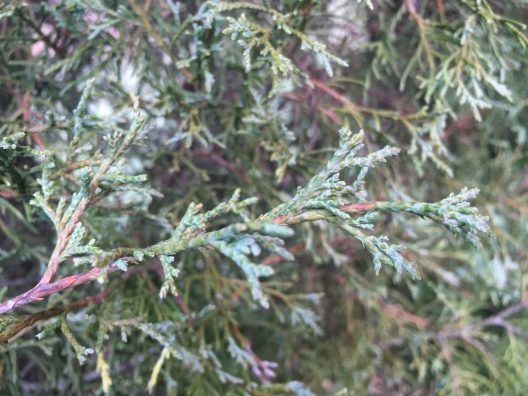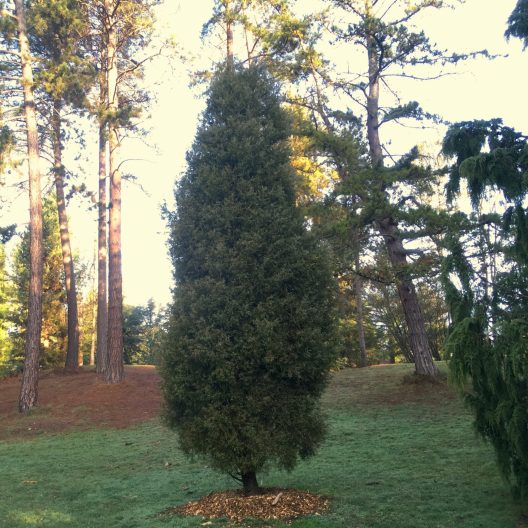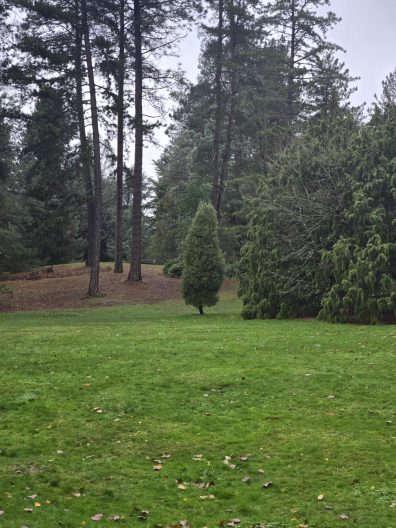December Plant Profile: Cupressus gigantea

Scientific Name: Cupressus gigantea
Common Name: Tsangpo cypress or Tibetan Cypress
Family: Cupressaceae
Native Range: Yarlung Tsangpo valley and nearby valleys in Tibet
Location in the Arboretum: On both the north and south ends of the Pinetum section at the Washington Park Arboretum
Cupressus gigantea, Tibetan, giant or Tsangpo cypress, is a conifer in the Cupressaceae family that is endemic to the Yarlung Tsangpo valley and nearby valleys in Tibet. It is known colloquially as ju bai. According to conifer expert Aljos Farjon, “Large trees are often venerated in local tradition and religion.” While it is considered vulnerable to extinction in the wild due to habitat fragmentation and loss, its conservation is possible, in part, by its designation as a ‘sacred forest’ by local Buddhist monks. This area can be found on the map by following the Himalayas along the top of the continent of India to the country of Bhutan. The area where this tree can be found is on the section of the Tsangpo due northwest of central Bhutan across the border in Tibet, China. Cypress wood is milled and mixed with over 30 herbs to make Tibetan incense in the Toinba Township, a process that includes skilled incense artisans who have been making it for over 1,300 years!
The tree’s ecology is described as dry inner valleys and semi-arid dry mountain environments at high elevation (10,000-11,000’), where C. gigantea can be found in isolated stands. Due to the remoteness of the region, seeds can be difficult to acquire and study. Tibetan cypress can be susceptible to cypress canker, a fungus that infects branches, causing trees to be girdled and kills tissue down to the cambium beyond the canker (Science Direct).
 In maturity, this long-lived giant can reach a heights of over 150 feet and a trunk diameter of about 20 feet and live to be 1,000 years old! Seed cones are described as individual or in groups near the upper ends of branches, 0.4 – 0.6 in. long, nearly spherical (sub-globose) when closed, brown when mature with parting scales. The tree’s low seed-setting rate, extensive habitat loss, and cultural significance as well as timber and firewood production contribute to this tree’s status as endangered (Ji et al 2024). Regeneration is poor because grazing livestock eats the young trees (Farjon, 2005). Cupressus gigantea was previously classified as a subspecies of Cupressus torulosa, or the Himalayan cypress. These species are very similar in size and appearance and grow in the same areas. However, recent genetic studies have shown these species are in fact separate (Fu et al, 2019).
In maturity, this long-lived giant can reach a heights of over 150 feet and a trunk diameter of about 20 feet and live to be 1,000 years old! Seed cones are described as individual or in groups near the upper ends of branches, 0.4 – 0.6 in. long, nearly spherical (sub-globose) when closed, brown when mature with parting scales. The tree’s low seed-setting rate, extensive habitat loss, and cultural significance as well as timber and firewood production contribute to this tree’s status as endangered (Ji et al 2024). Regeneration is poor because grazing livestock eats the young trees (Farjon, 2005). Cupressus gigantea was previously classified as a subspecies of Cupressus torulosa, or the Himalayan cypress. These species are very similar in size and appearance and grow in the same areas. However, recent genetic studies have shown these species are in fact separate (Fu et al, 2019).
The Washington Park Arboretum had five specimens in the park; three on the south end of the Pinetum and two on the north end. On the south end, closer to the Newton Street entrance, specimen 201-99-C appears much shorter than the Pinus monticola (western white pine) and stately Juniperus morrisonicola conifers in the backdrop but makes up for it with its fullness and distinct conical shape. This specimen was moved to its current location in 2011 from the field nursery and is itself a cutting from the Arboretum’s original 1948 specimen. Unfortunately, a specimen planted in 2022 was illegally cut down in November of 2024, presumably for Christmas decoration. This originated from wild collected seed, which was shared with us by Rhododendron Species Garden in Federal Way to help preserve the genetic diversity of this threatened species.

Sources
Farjon, 2005’ refers to book A Monograph of Cupressaceae and Sciadopitus, authored by conifer expert Aljos Farjon and found in the CUH library (Call number SB414.C975 F27 2005)
The fungus causing cypress canker – ScienceDirect
Incense production video: https://youtu.be/JW5bgIP0H_I?si=_sTQUZpDeRdG0xJ-